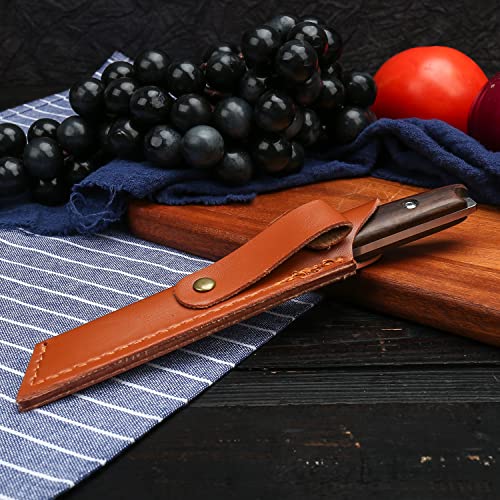Looking at all the different knives in your new set, you may ponder, “what is a utility knife used for?” Unfortunately, reflecting on the question won’t get you anywhere, but reading an informative article might!
This utility knife review will teach you precisely what this handy little kitchen knife is used for. We’ll also examine how it weighs up against your other kitchen knives.
What is a utility knife?
The kitchen utility knife is a medium size knife you can use for various tasks, from chopping up fruits to opening up packets of frozen goods. As its name suggests, it is a knife that provides “utility.” That is, usefulness in situations where big chef’s knives or small paring knives are unsuitable for the job.
A perfect example of using a utility knife is cutting citrus fruits like oranges and lemons (1). These ingredients are typically within the ideal range for the knife’s size and blade length.
Origins of the utility knife
The utility knife was not designed to perform any specific tasks but rather to cover the shortcomings of the other knives in a standard set. It is larger than a paring knife but smaller than a chef’s knife. It is often referred to as a “sandwich knife” or “fruit knife” for its ability to take on ingredients of that size range.
It’s also a good size for cutting open packets of frozen goods or for delicate tasks like cutting smaller pieces of cheese and fruits for a platter.
In essence, the smaller blade takes on many qualities of a chef’s knife. Notably, its ability to be a multi-purpose cutting tool for a wide range of food ingredients. Unlike the full-size blade of the chef’s knife, this one allows you to save on space and costs. It offers a smaller-sized solution that can still perform most key kitchen tasks.
If you consider yourself a minimalist, the utility knife is the perfect tool for chopping vegetables, carving fruits, and dicing meats. It covers all your essential food-cutting needs.
Historically, people refer to pocket knives as utility knives, such as the Swiss army knife by Victorinox (2). However, when people mention the term “utility knife” it now can refer to kitchen ones too. It describes the multi-purpose facets of the tool and its compact size and convenience of use.
While the term utility knife is still used this way, kitchen knives are now considered utility knives.
Key features
Some of the key features of the utility knife include its unique size of about 4-7 inches in blade length. This puts it in a special range between a small paring knife and a large chef’s knife. This provides mobility and cutting potential unseen in most knives.
As such, it can be the perfect tool for medium-sized tasks. These include cutting sandwiches in half and opening packets of frozen goods, cheese, or crackers.
Utility knives are typically made with razor-sharp stainless steel. The blade is usually relatively thin with a pointed tip, allowing it to pierce through ingredients with a tough exterior texture. The average utility knife blade is sharpened to about 14 or 15-degree blade angles per side, making it sharper than the average knife.
The edge is usually slightly curved, which allows you to apply a minimal rocking motion movement for chopping and dicing vegetables.
Types of utility knives
Regarding the material and design, utility knives differ from brand to brand and even country to country. For instance, a western-style utility knife will feature softer steel of about 57 HRC. This allows its inner cells to bend to the shape of the ingredient to prevent chips and cracks in the blade when under pressure.
Contrastingly, Japanese utility knives are built with super steel materials that can reach a Rockwell Hardness score of about 60 HRC. This improves its cutting power at the cost of some durability.
They also come in many different handle designs and materials. Each offers unique benefits that ultimately come down to personal preference. Western utility knives are made with riveted synthetic materials that usually feature a finger safety lock. This optimizes ergonomics and promotes safety.
On the other hand, Japanese knives come with a D-shaped handle made of Pakkawood or Tagayasan wooden materials. These offer a beautiful aesthetic but a questionable design in terms of ergonomics.
In addition to differences in materials and handle designs, there are utility knives with straight-edged and serrated blades. People tend to use the former for effectively cutting vegetables and fruits. Then, they prefer the latter for cutting through bread, much like a smaller serrated bread knife.
As with most kitchen knives, these are available as stamped or forged blades. These offer different levels of durability and sharpness. Stamped blades are more affordable but break more easily than forged blades. Although some prefer the ultra-thin and sharp edge it can offer.
However, a forged utility knife is second-to-none regarding long-lasting durability and hardness. Though priced significantly higher, it offers cutting prowess and resistance to cracks and chips.
Related: The Different Types of Kitchen Knives and What They’re Used for
Pros of the utility knife
There are quite a few advantages to using the utility knife, eliminating the need for additional kitchen knives. Some of the main benefits of it are listed below:
Multi-purpose
Indeed, like its older sibling, the chef’s knife, the utility knife is also a multi-purpose jack-of-all-trades knife, just a little smaller. It can tackle most of the tasks of a chef’s knife, such as chopping meat, chicken, and vegetables. It can also do many smaller ingredients you’d use a carving knife, such as peeling fruits and slicing cheese.
The sharp thin blade and the slightly curved edge of the blade make it an excellent tool for a wider variety of cutting techniques. These include slicing, dicing, and chopping a range of ingredient types.
Unique usage
The utility knife is at an ideal blade length to perform many unique tasks that are difficult for a paring or chef’s knife. Its medium size can be a significant advantage for the proper home cook. This opens the gate to even more cutting tasks that are a little more intricate.
Such unique cutting tasks extend beyond the realm of meat and veggie tasks. These include cutting sandwiches, summer sausage sizzles, small but hard vegetables, dull apples, and hard cheeses.
Large product offerings
One of the best things about a sharp utility knife is that it’s one of the few kitchen tools with a massive range of design and material choices. For example, some brands offer smooth straight-edge ones for uniform dicing, while others provide a curved blade for rock-chopping motions.
There is also the option of serrated knives in this category which optimize the bread-cutting experience or can be used as a steak knife for medium-sized meats.
Related: Type Of Knife Edges: How Do They Work?
Cons of the utility knife
Not every knife is perfect, and even this jack-of-all-trades knife can be used for the wrong reasons if not mindful. Here is a list of disadvantages and things to avoid when using a utility knife.
Does not specialize in anything
A bread knife is called such for a reason, and the same goes for a meat cleaver, vegetable knife, and carving knife. In the same sense, a utility knife is named in such a way because it truly has no specialty, and there will always be a knife that can do a utility knife task better.
The utility knife is unique because of its wide range of usage and ability to bring satisfactory results in almost any area. Still, it should never replace a butcher’s knife or a professional-grade vegetable cleaver.
Cannot cut large-sized ingredients
You should not use your utility knife for tasks that are too large-scale for them. Some include thick chopping cuts of meat or opening up a large pineapple or coconut. You can probably get the job done with enough force, but chances are your knife will sustain severe, often irreversible, damage to the blade.
It is essential to stick to ingredients it can handle, such as cutting small portions of meat, fruits, vegetables, bread, and cheeses.
Best ways to use and care for a utility knife
The best way to use a utility knife is to cut up fruits, vegetables, small portions of meat and chicken, and slice up sandwiches and cheese. You should avoid washing it with a dishwasher to avoid rusting or corrosion. Instead, it’s best to store it in a knife block for safety and a long lifespan.
The sharp edges of utility knives need to be maintained through a sharpening stone and honing steel rod. Special tools need to be used to handle utility knives with a serrated edge.
Utility knife vs paring knife
The utility knife is a couple of inches longer than the paring knife, though it can typically perform many of the same tasks. A size of 4-7 inches makes it perfect for cutting surface textures like citrus fruits and hard cheeses.
Comparatively, the paring knife comes in at less than 4 inches. As a result, it’s ideal for delicate work such as peeling the skin off potatoes or removing fruit seeds.
Utility knife vs chef’s knife
The utility and chef’s knives are fairly sharp and excel in durability, flexibility, and multi-purpose use. Regarding materials, design, and intended use, both knives are more similar than they are different.
The distinctive feature that separates chef’s knives from utility knives is the size of the blade. It comes in at 4-7 inches, while the chef’s knife extends to the 8-12 inch range.
Related: Best Chef Knife Under $100: The Top 10 Chef Knives
What is a utility knife FAQ
What is utility knife used for?
The utility knife is used for various small to medium-sized tasks such as cutting fruits, peeling potatoes, and chopping up small pieces of meat and chicken. They can also be used as steak knives, particularly those with a serrated edge, allowing the user to cut up pieces of steak or roast beef into thin slices for the family to enjoy.
What knife is used as a utility knife?
The term “utility knife” was traditionally used to refer to the Swiss army pocket knife, a helpful tool carried around in the pocket, often consisting of screwdrivers and picks along with other things.
Now, the utility knife can also describe a type of kitchen knife between the sizes of a paring knife and a chef’s knife, offering a unique functionality to take on a range of primary and minor cutting tasks.
What do you cut with a utility knife?
Common ingredients ideal for a utility knife includes citrus fruits, cheeses, breads, and small portions of meat, poultry, and fish. In addition to food-related tasks, it also works well for opening up packets of ingredients in the kitchen or even for cutting up empty cardboard packaging for easy disposal.










